- Home
- Technical Cooperation Projects
- Index of Countries
- Middle East
- Egypt
- Project for Strengthening Water Management Transfer
- Project News
- First general workshop was held by the Project for Strengthening Water Management Transfer (SWMT Project).
Project News
2013-04-18
First general workshop was held by the Project for Strengthening Water Management Transfer (SWMT Project).
The SWMT Project had the first general workshop in the conference hall of the Central Department of Irrigation Advisory Service (CDIAS) in Ministry of Water Resources and Irrigation (MWRI) on April 14, 2013. There were 57 participants in total who were not only from the CDIAS, Training Sector for Water Resources and Irrigation (TSWRI) and Irrigation Sector (IS) of the MWRI which are Counterparts (CP) of the SWMT Project, but also from the Irrigation Advisory Service (IAS) and the Branch Canal Water Users' Association (BCWUA) in each of the three pilot sites and from the BCWUAs in the pilot sites of Water Management Improvement Project II (WMIP 2). Main objective of the workshop was to confirm contents and importance of the project activities by all the stakeholders in advance of implementing them in the pilot sites, while aiming especially at enhancing their willing to participate in the SWMT Project through directly sharing information and experiences on the Joint Repair Work (JRW) and environmental campaigns with participants in the WMIP 2 activities.
At the beginning of the workshop, Eng. Nagwa El Khashab, Head of the CDIAS and Manager of the SWMT Project explained about progress of the SWMT Project since its start in the last November. After her presentation, Eng. Kunihiko Naito, Chief Advisor of the SWMT Project had his presentation about summary of the project activities in the pilot sites, while Eng. Yutaka Ueno, Technical Expert explained about contents and schedule of the basic survey in the pilot sites. Following their presentations, a video program of a JICA's technical cooperation project on participatory water management by farmers in Sri Lanka which was dubbed in Arabic by the CDIAS staff, was screened so that the participants can enough understand the concepts of the SWMT Project.
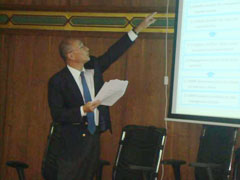 Eng. Naito explaining about the project activities in the pilot sites.
Eng. Naito explaining about the project activities in the pilot sites.
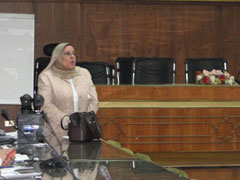 Eng. Nagwa introducing about the activities of the SWMT Project.
Eng. Nagwa introducing about the activities of the SWMT Project.
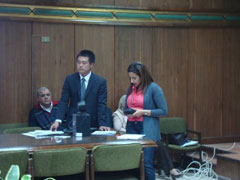 Eng. Ueno explaining about the basic survey in the pilot sites with Ms. Iman, a Project Assistant.
Eng. Ueno explaining about the basic survey in the pilot sites with Ms. Iman, a Project Assistant.
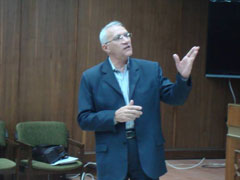 Eng. Ahmed, CDIAS explaining about the activities of the WMIP 2.
Eng. Ahmed, CDIAS explaining about the activities of the WMIP 2.
After the video program, presentations were given to the participants on overview and lessons learned of the WMIP 2 by CP staff, using many photos of the JRW and the environmental campaigns. Following their presentations, BCWUA members of the WMIP 2 had their presentations on the activities and their impacts in their areas. Participants from the pilot sites of the SWMT Project were seriously listening to their experiences in the WMIP 2. It was impressive to hear from a BCWUA member in Rash El Garbi that the environmental campaign of the WMIP 2 taught them importance of tackling environmental issues fundamentally as well as sustainably by decreasing quantities of garbage every day rather than by collecting garbage and cleaning the canals just temporarily.
Thereafter, participants were divided into three working groups to discuss three topics of JRW, Operation and maintenance of the canals and other activities, and Water measurement and redistribution which will be implemented in the SWMT Project. Each group actively discussed their issues and solutions related to each topic. The representative of each group had a presentation about results of their discussions at the end. The participants of the WMIP 2 were very informative as they shared their own experiences in Participatory Rural Appraisal (PRA) and awareness raising activities with mosques, schools and residential units in their areas with other participants.
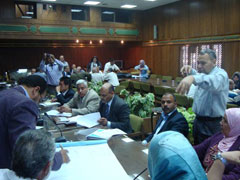 Participants discussing in the working groups.
Participants discussing in the working groups.
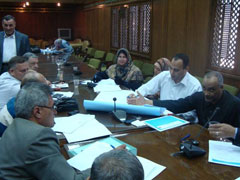 Participants discussing in the working groups.
Participants discussing in the working groups.
At the last part of the workshop, there was selection of a logo-mark of the SWMT Project out of several logo-marks which were proposed by the project staff. All the participants gave a vote to select one logo-mark. As a result, a logo-mark which was made by Eng. Ueno was selected as the logo-mark of the SWMT Project.
Finally, Eng. Naito gave his appreciations to all the participants for their participation in the workshop, while requesting participants from the project sites of the WMIP 2 to give their continuous support to the SWMT Project, and the workshop was successfully ended.
As the result of the workshop, BCWUA members in the three pilot sites as well as CP staffs could understand the project activities and importance, enhancing their willing to participate in the SWMT Project. To meet their expectations to the SWMT Project, we will continuously do our best to implement the project activities successfully with all the project members as a team.
 Participants selecting a logo-mark for the SWMT Project.
Participants selecting a logo-mark for the SWMT Project.
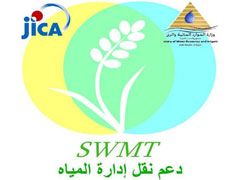 Logo-mark that was selected for the SWMT Project.
Logo-mark that was selected for the SWMT Project.
- About JICA
- News & Features
- Countries & Regions
- Our Work
- Thematic Issues
- Types of Assistance
- Partnerships with Other Development Partners
- Climate Change / Environmental and Social Considerations
- Evaluations
- Compliance and Anti-corruption
- Science and Technology Cooperation on Global Issues
- Research
- JICA Development Studies Program / JICA Chair
- Support for the Acceptance of Foreign HRs / Multicultural and Inclusive Community
- Publications
- Investor Relations
